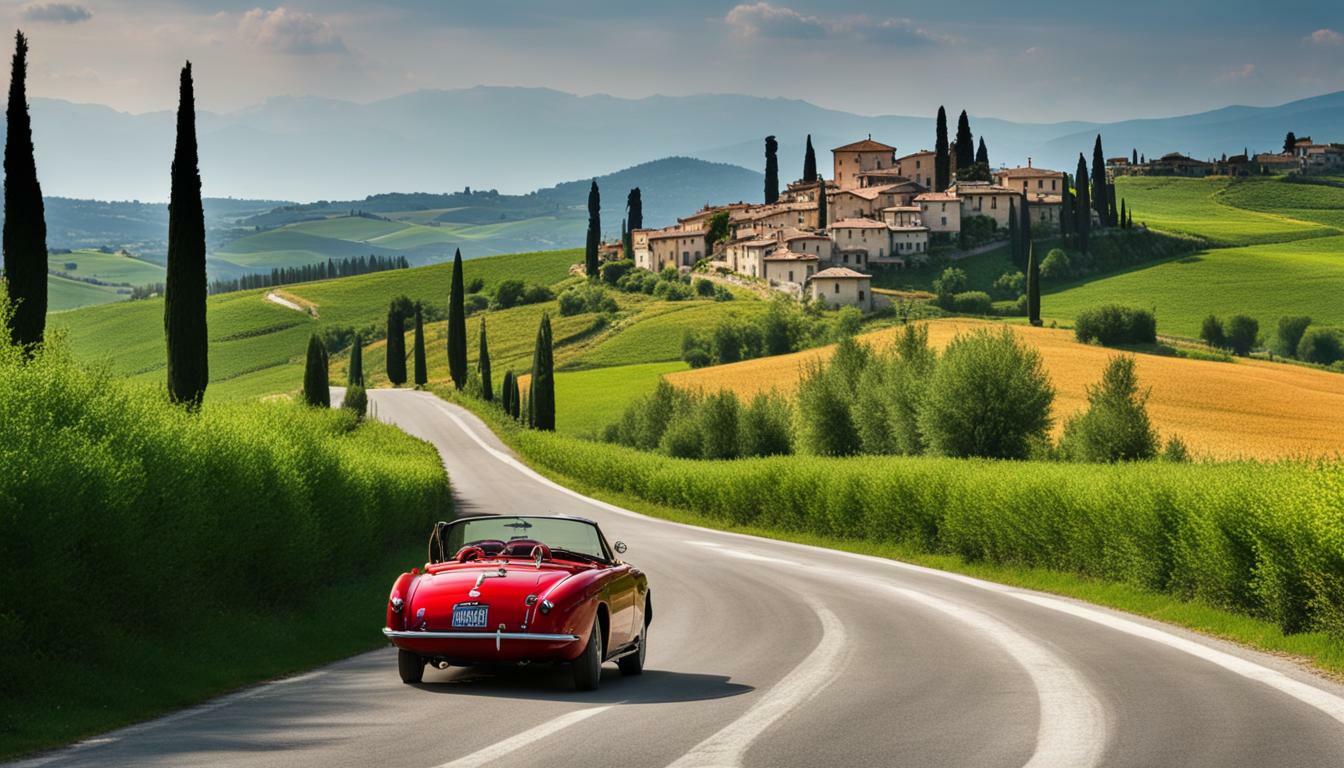Driving in Italy
Driving in Italy is an exhilarating experience that offers a unique opportunity to explore the country's scenic routes and discover the local charm on an Italian road trip. While it may seem intimidating at first, rest assured that it is definitely doable and can be a rewarding adventure. Italian drivers, though occasionally impatient, are not as bad as movies may portray. In fact, they add to the excitement of the journey.
Regions like Tuscany and Puglia are highly recommended for driving in Italy. Not only do they boast well-maintained roads, but they also showcase the breathtaking countryside and picturesque landscapes that will make your road trip truly memorable.
Key Takeaways:
- An International Driving Permit is not required at the rental desk, but having one is recommended in case of police checks.
- Avoid driving in major cities like Naples and Palermo, as heavy traffic and narrow streets can be challenging.
- Italian drivers can be aggressive and may not always use turn signals, so prioritize safety and be especially cautious.
- Remember that turning right on red is not allowed in Italy.
- Seat belts are required by law, and it's advisable to have a spare tire and safety vest in the car for emergencies.
When exploring Italy, certain regions like the Dolomites, Sardinia, Sicily, and mountainous areas are better enjoyed by car, providing stunning scenery along the way. However, driving in cities like Naples and Palermo can be challenging due to heavy traffic and restricted access zones (ZTL).
Keep valuables out of sight in the car and rely on a GPS system for navigation, preferably with a paper map as a backup. And lastly, make sure to follow local driving laws and regulations, as traffic violations can result in fines that may put a damper on your road trip.
Driving Laws and Regulations
Familiarizing yourself with the driving laws and regulations in Italy is essential for a smooth and enjoyable journey on the country's roads. While driving in Italy may seem daunting at first, understanding the rules of the road will help you navigate confidently and avoid any unnecessary fines or penalties.
Italian driving laws are similar to those in many other European countries. It is mandatory to carry a valid driving license, and if you are a non-EU citizen, an International Driving Permit is recommended. This permit is not required at the rental desk, but it may be necessary in case of police checks. It is advisable to obtain one before your trip to ensure a hassle-free experience.
When it comes to road etiquette in Italy, it's important to note that Italian drivers can be a bit aggressive and may not always use turn signals. It is crucial to prioritize safety and be aware of traffic signals and signs. Additionally, it is worth mentioning that in Italy, turning right on a red light is not permitted.
Seat belts are mandatory for all occupants of a vehicle, and it is important to ensure that everyone is buckled up. It is also recommended to have a spare tire and a safety vest in your car, as these items are required by law in case of emergencies or breakdowns. Following these safety precautions will contribute to a more pleasant and secure journey while exploring the beautiful landscapes of Italy.
Road Signs and Etiquette
Understanding the road signs and learning the driving etiquette in Italy ensures a safe and pleasant driving experience on the country's roads. Italian drivers can be a bit aggressive, and you may find that they don't always use turn signals. However, with a few tips and knowledge of the road signs, you can navigate the Italian roads with confidence.
When driving in Italy, it's essential to prioritize safety. Always wear your seat belt, as it is required by law. Additionally, be aware of traffic lights and follow the rules of the road. In Italy, turning right on red is not allowed, so make sure to wait for a green light before proceeding.
| Road Sign | Meaning |
|---|---|
| The stop sign indicates that you must come to a complete stop before proceeding. | |
| The yield sign means that you must give the right-of-way to vehicles approaching from another direction. | |
| The speed limit sign indicates the maximum speed allowed on the road. It's important to adhere to the speed limits to ensure your safety and avoid fines. |
It's also worth noting that Italy has a system of restricted access zones in city centers called ZTL. These zones are marked with specific signage, and it's important to pay attention to them to avoid fines. If you're unsure about whether you can enter a certain area, it's best to park your car outside and explore the city on foot or using public transportation.
Driving Etiquette
“When in Rome, do as the Romans do.” This saying holds true when it comes to driving in Italy. Italian drivers have their own unique rules and etiquette on the road. Here are a few tips to keep in mind:
- Be assertive but not aggressive. Italian drivers can be bold, so it's important to assert yourself on the road, but without crossing the line into aggressive behavior.
- Use your horn sparingly. Honking is not as common in Italy as it is in some other countries. Only use your horn when necessary, such as to alert another driver of your presence.
- Be cautious when overtaking. If you need to overtake another vehicle, make sure it's safe to do so. Use your turn signals and wait for the right moment.
By understanding the road signs, following the driving etiquette, and prioritizing safety, you can have a memorable and enjoyable driving experience in Italy. So buckle up, keep your eyes on the road, and get ready to explore the beautiful sights that Italy has to offer.
Renting a Car in Italy
Renting a car in Italy is a convenient way to explore the country, and knowing the process and tips can make the experience hassle-free. Whether you're planning a road trip through Tuscany's rolling hills or venturing off the beaten path in Puglia, having your own wheels gives you the freedom to discover hidden gems and soak in the stunning scenery. Here are some essential things to consider when renting a car in Italy.
Requirements and Documentation
“To rent a car in Italy, you must meet certain requirements and provide the necessary documentation,” explains Mario Rossi, a local car rental specialist. “Most rental companies require drivers to be at least 21 years old and hold a valid driver's license. It's also important to have a credit card in the main driver's name for the deposit.”
While an International Driving Permit (IDP) is not required at the rental desk, it is recommended to have one. The IDP serves as a translation of your driver's license and can come in handy in case of any language barriers or police checks during your trip.
| Requirements | Documentation |
|---|---|
| Minimum age | 21 years old |
| Driver's license | Valid license from your home country |
| Credit card | Main driver's credit card for deposit |
Tips for a Smooth Rental Experience
- Book in advance: To secure the best rates and ensure availability, it's recommended to book your car rental in advance, especially during peak travel seasons.
- Inspect the car: Before driving off, thoroughly inspect the car for any existing damages and take photos or videos as evidence. This will help avoid any disputes or additional charges upon return.
- Get familiar with the vehicle: Take a few minutes to familiarize yourself with the car's features, including the location of headlights, turn signals, and windshield wipers. It's also a good idea to ask the rental company about any specific driving regulations or quirks in the local area.
“Renting a car in Italy gives you the freedom to explore at your own pace. Just remember to follow local driving laws, stay safe, and immerse yourself in the beauty of this enchanting country,” advises Mario Rossi, the local car rental specialist.
By understanding the rental process and following these tips, you'll be well-prepared to embark on an unforgettable journey through Italy. Whether you're cruising along the Amalfi Coast or venturing deep into the heart of the Italian countryside, a rented car opens up a world of possibilities and allows you to create your own adventure.
Driving in Italian Cities
Navigating the streets of Italian cities requires extra attention and caution, as they can be crowded and challenging to drive through. In cities like Naples and Palermo, heavy traffic and narrow streets make driving a less-than-ideal choice. It's best to opt for public transportation or explore on foot in these bustling urban centers.
However, if you do find yourself behind the wheel in an Italian city, there are some important tips to keep in mind. Italian drivers can be a bit aggressive, so it's important to stay focused and alert. Be prepared for drivers who may not always use turn signals or yield right of way.
Another crucial point to remember is that turning right on red is strictly prohibited in Italy. Always wait for a green light before proceeding, even if it may seem tempting to make a turn.
| Driving in Italian Cities: Tips and Guidelines | |
|---|---|
| 1. Be patient and attentive. Italian traffic can be chaotic, so always anticipate sudden maneuvers from other drivers. | “It's important to stay focused and alert.” |
| 2. Familiarize yourself with local traffic laws and regulations. This will help you navigate the roads more confidently and avoid any unnecessary fines. | “Always wait for a green light before proceeding.” |
| 3. Pay attention to restricted access zones (ZTL) in city centers. These areas are marked with specific signage and have limited access for vehicles. Violating these restrictions can result in hefty fines. | “Keep an eye out for restricted access zones.” |
| 4. Plan your parking in advance. Parking spaces in Italian cities can be scarce, so consider using public parking lots or garages instead of searching for street parking. | “Consider using public parking lots or garages.” |
Remember, driving in Italian cities can be a test of patience and adaptability. It's often more enjoyable to explore on foot or use public transportation to soak in the vibrant atmosphere. Be cautious, follow traffic rules, and savor the rich cultural experience that these cities have to offer.
Driving in Rural Italy
Embarking on a road trip through rural Italy allows for breathtaking views and an opportunity to immerse oneself in the country's natural beauty. The scenic landscapes of regions like Tuscany, Puglia, the Dolomites, Sardinia, Sicily, and the mountainous areas offer a picturesque backdrop for an unforgettable driving experience. Whether winding through vineyards, exploring coastal towns, or navigating narrow mountain roads, rural Italy is a paradise for road trip enthusiasts.
Driving through rural Italy provides the freedom to discover hidden gems and off-the-beaten-path destinations. The well-maintained roads in these regions make for a smooth and enjoyable journey. Surrounded by vineyards, olive groves, and rolling hills, every twist and turn in the road reveals a new stunning vista. The slower pace of rural life allows travelers to truly savor the beauty of the Italian countryside.
Recommended Regions for Rural Drives
| Region | Highlights |
|---|---|
| Tuscany | Chianti wine region, Val d'Orcia, Tuscan hill towns |
| Puglia | Trulli houses in Alberobello, coastal towns like Polignano a Mare, the Baroque city of Lecce |
| The Dolomites | Stunning mountain views, scenic drives through mountain passes |
| Sardinia | Crystal-clear beaches, rugged coastline, picturesque villages like Castelsardo |
| Sicily | Mount Etna, ancient ruins, charming towns like Taormina and Siracusa |
While rural driving offers an unforgettable experience, it's important to remain cautious on the roads. The narrow and winding nature of some rural routes may require extra attention and care. Additionally, it's advisable to have a GPS system with a paper map as a backup, as signage can sometimes be limited in remote areas.
Exploring rural Italy by car allows travelers to soak in the natural splendor, discover hidden gems, and experience the charm of the countryside. With its breathtaking views, tranquil landscapes, and rich cultural heritage, rural Italy is a dream destination for those seeking an authentic and unforgettable road trip adventure.
Safety and Essential Items
Prioritizing safety and being prepared with essential items ensures a secure and worry-free driving experience in Italy. It is important to adhere to local driving laws and regulations, as traffic violations can result in fines. Seat belts are required by law, so make sure to buckle up before hitting the road.
When renting a car, it is advisable to check if there is a spare tire included. Road conditions in Italy can vary, and having a spare tire can be a real lifesaver in case of a flat. Additionally, having a safety vest in the car is recommended. In case of any roadside emergencies, the safety vest will make you more visible to other drivers and help ensure your safety.
Italy offers stunning countryside and scenic routes, making it an ideal destination for road trips. Exploring regions like the Dolomites, Sardinia, Sicily, and mountainous areas is best done by car. However, driving in major cities like Naples and Palermo can be challenging due to heavy traffic and narrow streets. It's best to avoid driving in these cities if possible.
Italy has a system of restricted access zones in city centers, known as ZTL. It's important to pay attention to the signage and avoid entering these zones unless you have the necessary permits. Violations can result in significant fines. To navigate your way around, it's recommended to use a GPS system, preferably with a paper map as a backup. This will help you stay on track and avoid any unnecessary detours.
| Essential Items for Driving in Italy |
|---|
| Seat belts |
| Spare tire |
| Safety vest |
| GPS system with paper map |
By following these safety precautions and being mindful of local driving regulations, you can have a memorable and enjoyable driving experience in Italy. So buckle up, keep your safety vest handy, and embark on an adventure to discover the beauty and charm of this captivating country.
Conclusion
Driving in Italy offers an exhilarating adventure, and with a proper understanding of the driving laws, etiquette, and safety measures, it becomes a memorable Italian road trip worth embarking on. Factual data reveals that while it may initially seem intimidating, Italian drivers are not as bad as portrayed in movies. Regions like Tuscany and Puglia provide beautiful scenery and well-maintained roads, making them ideal for a road trip.
When it comes to road etiquette, it is important to prioritize safety and be aware of traffic lights. Italian drivers can be a bit aggressive and may not always use turn signals. It's crucial to follow local driving laws and regulations to avoid fines. For example, turning right on red is not allowed in Italy. Seat belts are required, and it's advisable to have a spare tire and safety vest in the car.
While driving in Italian cities can be challenging due to heavy traffic and narrow streets, exploring rural areas can be a picturesque experience. Regions like the Dolomites, Sardinia, Sicily, and mountainous areas offer scenic beauty and well-maintained roads. However, it's recommended to avoid driving in major cities like Naples and Palermo. Italy also has a system of restricted access zones in city centers called ZTL, so it's essential to pay attention to signage to avoid fines.
Lastly, it's important to prioritize safety by not leaving valuables in the car and using a GPS system with a paper map as a backup. Following these precautions ensures a smooth and enjoyable Italian road trip. With a sense of adventure and a willingness to embrace the unique driving culture, exploring Italy by car can be an unforgettable experience.
FAQ
Is driving in Italy difficult?
Driving in Italy can be a little intimidating for some, but it is definitely doable and can offer a unique and rewarding experience.
Are Italian drivers as bad as movies portray?
No, Italian drivers are not as bad as movies may portray. While sometimes impatient, they can be manageable to drive alongside.
Which regions in Italy are good for driving?
Tuscany and Puglia are great regions for driving, with good roads and beautiful countryside.
Do I need an International Driving Permit to drive in Italy?
An International Driving Permit is not required at the rental desk, but it is recommended to have one in case of police checks.
Should I drive in major cities like Naples and Palermo?
It's best to avoid driving in major cities like Naples and Palermo due to heavy traffic and narrow streets.
How would you describe Italian road etiquette?
Italian drivers can be a bit aggressive and don't always use turn signals. It's important to prioritize safety and be aware of traffic lights.
Can I turn right on red in Italy?
No, turning right on red is not allowed in Italy. You must wait for a green light.
What are the essential items to have in the car?
Seat belts are required by law, and it's recommended to have a spare tire and safety vest in the car. It's also advisable not to leave valuables in the car.
Are there any driving restrictions in Italian cities?
Yes, Italy has restricted access zones in city centers called ZTL. Pay attention to signage to avoid fines.
Is it recommended to use GPS while driving in Italy?
Yes, it's recommended to use a GPS system, preferably with a paper map as a backup, to navigate the roads effectively.
What are the consequences of traffic violations in Italy?
Traffic violations in Italy can result in fines, so it's important to follow local driving laws and regulations.



